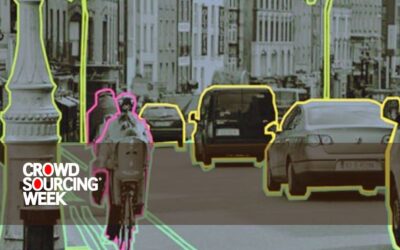Hi! We are Michael and Bonnie, the founders of the world’s largest wine brand. Did you know that we used crowdsourcing to build Barefoot Wine? Sure, it wasn’t called “Crowdsourcing” back then, but it was the secret to our success!
If Necessity is the Mother of Invention, Being Undercapitalized is Surely the Father!
It all started with an opportunity to turn a debt into a business. Our friend, a grape grower, hadn’t been paid for his grapes for three years. The only thing we could get out of the winery that owed him the money was a trade: debt for goods and services. The goods were bulk wine, and the services were bottling services.
We were undercapitalized and astonishingly deficient in industry knowledge. Then, all of a sudden, we had $300,000 worth of grapes and bottling services, but no clue as to what to do to convert those assets into cash. We were humbled. We started asking questions, lots of questions. We didn’t know it at the time, but we were crowdsourcing.
We asked everyone we met, not just the white collar crowd, but the folks with dirt under their fingernails. We talked to warehouse people, bottling line people, store clerks, truck drivers, and of course, wine lovers. Because we were from outside the industry, we started fresh in a rather staid and exclusive industry. Because we sourced from the proletariat, we got suggestions and ideas that disrupted the industry, like being fun and inclusive!
How We Discovered the Power of the Crowd
Our foray into early “crowdsourcing” didn’t stop there. In our humble beginning, we were turned down by the big store buyers because, “Nobody ever heard of something called ‘Barefoot Wine’ and nobody is going to buy a wine with a foot on it!” We had no money for advertising so we started selling the small independent markets that would take us. But they too threatened to discontinue us unless we showed them some sales right away. How were we going to get the word out without an advertising budget?
Then, out of the blue, we got a call from a San Francisco neighborhood group soliciting money for a kids-after-school park. We were surprised that they thought we had any money at all! We decided to give them some wine instead to use at their fundraiser. Maybe they could auction it off and raise some money for slides and swings, we thought. Or maybe it might loosen up some folks to write bigger checks!
It must have been a big hit because sales at the small stores in that neighborhood took off! We wondered, “Would this work in other neighborhoods?” We tried it in another neighborhood. It worked! And another. It worked there too!
 We were onto something. By supporting worthy causes in the neighborhoods that surrounded the stores where Barefoot Wine was for sale, we gave the members of those non-profit organizations a social reason to buy our products. We were “crowdsourcing” the crowd that lived near the stores! Even when we finally did have money for paid advertising, we decided to continue using what we called “Worthy Cause Marketing” in neighborhood after neighborhood, town after town, and region after region until we were a large national brand.
We were onto something. By supporting worthy causes in the neighborhoods that surrounded the stores where Barefoot Wine was for sale, we gave the members of those non-profit organizations a social reason to buy our products. We were “crowdsourcing” the crowd that lived near the stores! Even when we finally did have money for paid advertising, we decided to continue using what we called “Worthy Cause Marketing” in neighborhood after neighborhood, town after town, and region after region until we were a large national brand.
We also sent our winemaker and marketing people to the neighborhood fundraisers to listen to the feedback from the members. That feedback was invaluable. It determined our style, pricing, and branding. Again, we were crowdsourcing. We were accessing a platform that was already established, already networked, and already populated with qualified customers of our product.
Thus, Barefoot Wines became the fastest growing wine brand in the nation without commercial advertising.
Which Crowd are We Talking About?
Crowdsourcing has been around for centuries, but by and large, went by other names. The term “crowdsourcing” became the most commonly used descriptor of a very old idea: using the help, resources, and imagination of others to solve challenges. With the advent of information technology, we gained new and more efficient ways of accessing the crowd for funding, solutions, and feedback.
New platforms are popping up every week to access various crowds for various purposes. The advent of AI has taken crowdsourcing to a whole new level with its ability to quickly mine mountains of data for actionable results to help companies be more efficient and keep their products more relevant.
So, who is the “crowd” anyway? It could be a neighborhood, your own company, your industry, your customers, your prospects, entire professions, or the world at large. You set the dial! And that’s the beauty of crowdsourcing. It’s virtually unlimited in its reach.
Do You Need a Certain Attitude to Use Crowdsourcing Effectively?
Crowdsourcing is a problem-solving tool that everybody should have in their toolbox. But in order to use this tool, you must have the mindset to share information and encourage feedback. You must be open-minded enough to give the crowd permission to brainstorm. And you must be willing to accept the answers.
Let me give you an example of what I mean. One time we got good news and we got bad news. The good news was that Barefoot Wine was being test marketed in one of the largest chain stores in America. The bad news was that they put us on the bottom shelf! Nobody looks down! What were we going to do?
Many businesses operate on a need-to-know basis and wouldn’t think of sharing their marketing challenges with their staff. We believed in just the opposite. We kept everyone on a know-the-need basis.
 So, we had a meeting and told our entire staff about the dilemma. We asked for help. “Well,” the first person said, “We’re ‘Barefoot’, so I guess we’ll just have to rely on the foot traffic!” We all laughed. But then, somebody else said, “You know, that’s not such a bad idea! Why don’t we make some purple decal footprints and put them on the store’s floor? They will “walk” the shoppers down the wine aisle and turn them into where our products are on the bottom shelf. We’ll already have them looking down. When they see “Barefoot Wine” on the bottom shelf, they’ll get a good laugh and that’s halfway to the sale!”
So, we had a meeting and told our entire staff about the dilemma. We asked for help. “Well,” the first person said, “We’re ‘Barefoot’, so I guess we’ll just have to rely on the foot traffic!” We all laughed. But then, somebody else said, “You know, that’s not such a bad idea! Why don’t we make some purple decal footprints and put them on the store’s floor? They will “walk” the shoppers down the wine aisle and turn them into where our products are on the bottom shelf. We’ll already have them looking down. When they see “Barefoot Wine” on the bottom shelf, they’ll get a good laugh and that’s halfway to the sale!”
We put our purple feet down, passed the test, and eventually had these footprints in stores all over the country! And whose idea was that, you may ask. The receptionist’s! Looks like she needed to know the need.
Crowdsourcing requires an attitude of humility, sincerity, permission, transparency, and gratitude whether the crowd is around the block or around the world. We are excited to see where it will take us in business, medicine, and the environment. The page has definitely turned on accessing the full potential of the human race with crowdsourcing. “Ask and you shall receive!”
Crowd-related breakthroughs and the market disruption they can cause will be the subject of sector-leading speaker sessions and panel discussions at our next international conference, CSW Global 2019, running September 12-13 in San Francisco. Registration is open, you can reserve your place now.





0 Comments